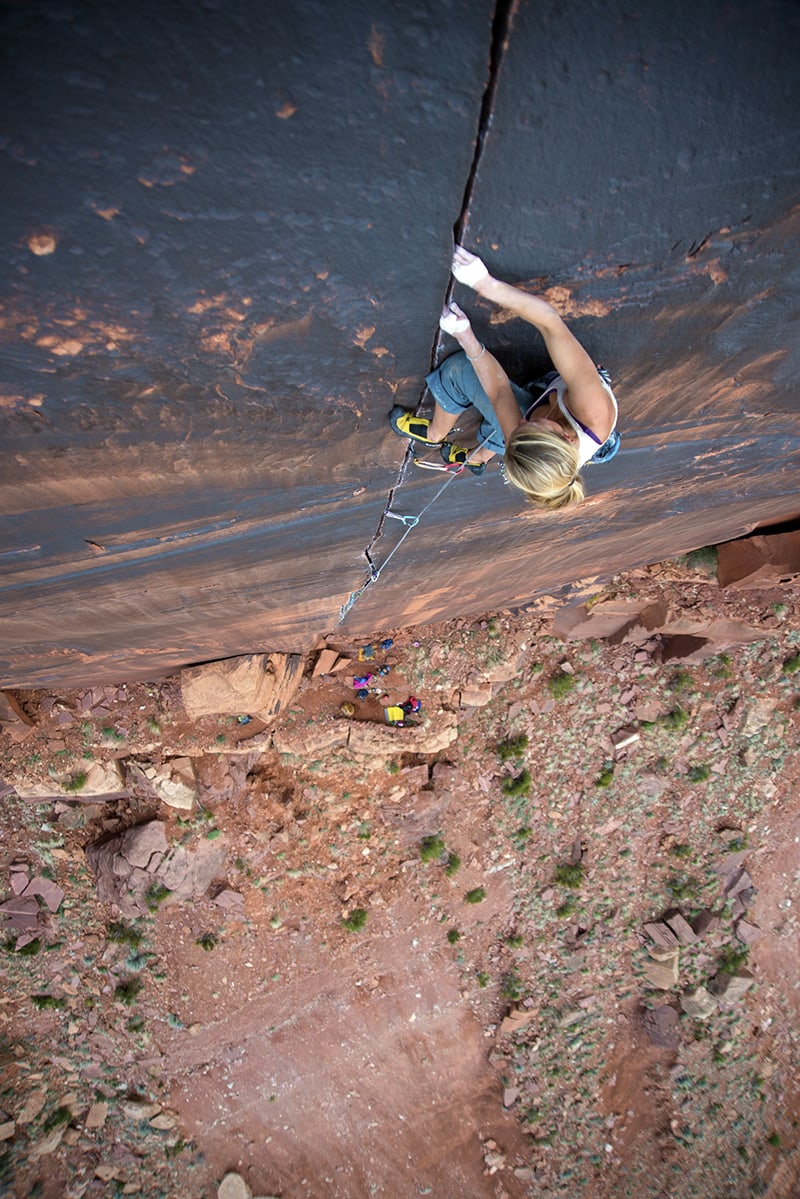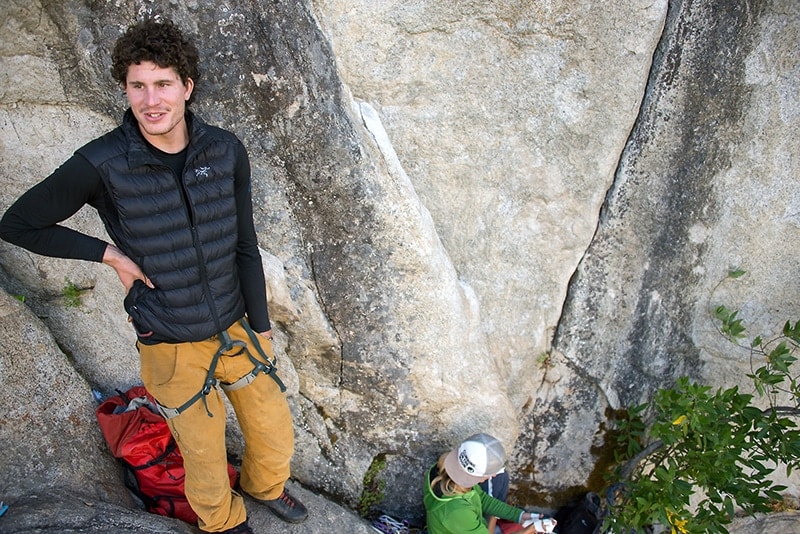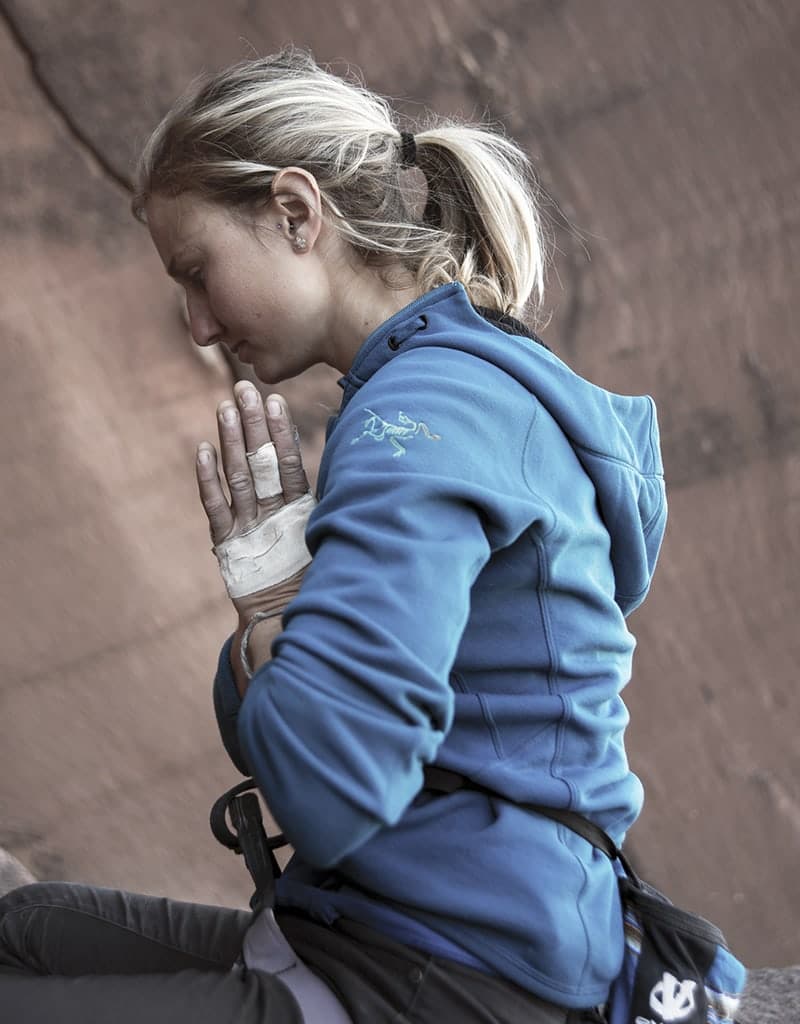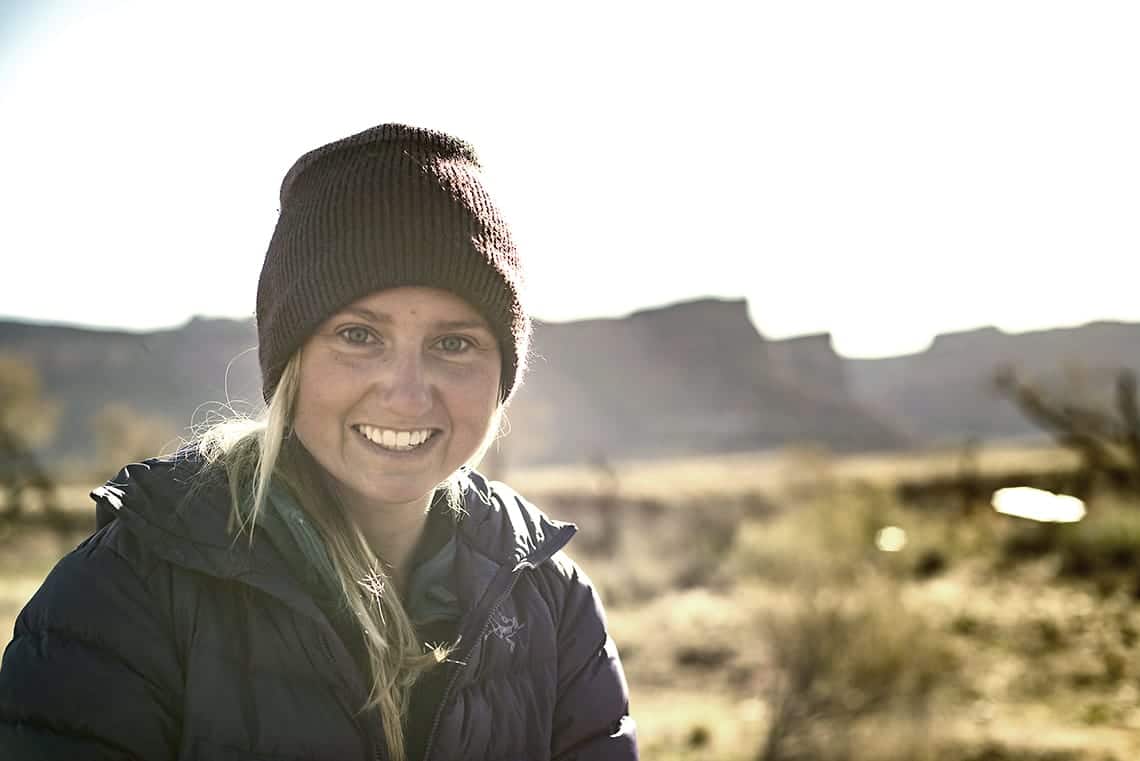The way some climbers are promoting themselves through social media often leaves me feeling that our sport’s soul is in rapid decline—something I know isn’t true, but still can’t help feeling cynical about at times.
Thankfully, climbing’s soul is hard to kill, and it still burns bright in people such as Brette Harrington, a climber who you may have never even heard about.
In fact, Brette is one of the best female trad climbers and free soloists out there.


Brette grew up in Lake Tahoe, and started sport climbing at age 15 in New Hampshire, where she attended a boarding school. From there, she moved on to trad climbing in Squamish, British Columbia, and has since become a staple member of this unassuming Canadian climbing community.
Today, Brette has amassed a number of impressive achievements, but perhaps the grandest one is when she free soloed, in just three hours, the 20-pitch Chiara di Luna (5.11a) on the west face of Saint Exupery, Patagonia, in February 2015. This route had been soloed before by Alex Huber in 2011, but he self-belayed sections using a rope. Brette’s was the first free solo of the route. Also, it was the first time a woman soloed, including free-soloed, to a Patagonian summit.
Climbing sans rope appears to be something that Brette enjoys. “If I go free soloing in the morning, my entire day is calm and peaceful after that,” she says.
Her hardest ascents have all been of trad climbs. She’s redpointed Grand Illusion (5.13c) at Sugarloaf, and she also nearly free climbed The Free Muir (5.13c) on El Capitan, sending every pitch except for one 5.12a traverse, where she fell at the crux and couldn’t return due to the nature of the traversing pitch.
She has also put up a number of first ascents that include Vanguardia (5.12c) and Catharsis Crack (5.10d), both in Squamish. She FA’d La Pluma (5.12b) and Semático Temático (5.10d, three pitches), and completed a first free ascent of Dividend del Espacio (5.12b, five pitches), all in Frey, Argentina.
In the great Waddington Range of B.C., she helped establish the first ascent of the Integral South Ridge of Dentiform (5.9 TD), and Straight No Chaser (5.11 A1 TD+) on the Direct South Ridge of Serra 2.
There aren’t many women that I know of who are putting up hard, new trad climbs in the mountains, and aside from the obvious example of Steph Davis, even fewer women are free-soloing big, long routes at a high level.
Recently, Brette and her boyfriend, Marc-Andre Leclerc (himself an exceptional free-soloist and alpinist, who recently nabbed the first free solo of Cerro Torre), have been working to establish a new six-pitch bolted route in the Hydrophobia cirque, in the Waiprous River Valley, outside of Canmore, Alberta.
“We bolted the entire route on lead, which was a new experience for me,” says Brette.
While bolting the route, the two camped in a tent in this remote region for month, a time in which they rarely saw another person. They charged their old Hilti batteries using a generator that they hiked in three kilometers from the car. At night, neon-green northern lights pulsated in the sky, so they decided to name the route Auroraphobia to keep with the “phobia”-themed names of the area.
They’ve redpointed all pitches of the entirely-overhanding route, except the second one. So far every pitch is either 5.12 or 5.13.
I reached out to Brette to find out more about who she is, just before she and Marc left on a two-month-long expedition to Baffin Island.
How did you get into climbing?
I was always interested in climbing. Even as a young kid I chose to do my school book reports on mountaineering novels such as Tenzing Norgay and Edmond Hillary’s Everest expedition. Climbing Everest became my first life dream. During those years my family began to take vacations to Yosemite, where I learned about wall climbing.
At age 16, I moved to New Hampshire where I went to a boarding school called Holderness. I joined the school climbing team. It was not a competitive team and we never climbed in gyms. We climbed at Rumney during the week, North Conway on the Saturdays, and went for trail runs when it rained.
I moved to British Columbia for university in Vancouver, and I spent my weekends climbing in Squamish.

How did you and Marc meet?
Marc and I met in Squamish. I was headed out climbing with his roommate and we stopped by their house to grab some things. Marc came out and offered me a smoke. I declined, but this started our friendship. I ended up living in their bouldering shed on the weekends, then moved onto the sofa that winter. We all climbed together for the next few years.

Do you prefer to climb with other women, or with men, or does it matter?
It really doesn’t matter for me the gender of who I’m climbing with because I can learn something new from everyone. It is, however, easier for me to understand a woman’s movements versus men’s, so I can follow beta and technique better. Marc has such a strong mind and, climbing with him, I’ve learned a great deal about managing fear and risk.

When did you realize you liked free soloing?
Free soloing came as a natural part of alpine climbing. The first alpine climb I went on involved a decent amount of free soloing across a 5.9-ish gully to escape rock fall, then a 4th class decent down the ridge.
How often do you solo?
I go through phases. Right now I solo almost every day, but I can go months without soloing anything. Marc and I team free-soloed an 1,100-meter peak called Mt. Colonel Foster the other day, which got me re-psyched on alpine scrambling. I solo multi-pitches on the Chief in Squamish, usually in the 5.9 to 5.10 range. I’m quite particular in choosing the routes I free solo and back off frequently.

In 2015, you had a big breakthrough year in Patagonia with your solo of Chiara di Luna. This past season, you returned and it seemed like many people were expecting a repeat performance. What happened?
I got super sick in Patagonia this season. What started as a minor cold transformed into full-blown pneumonia and lung infection after I attempted to climb in the Chaltén Massif. I think it was the long approach carrying heavy backpacks that really did me in. I went to the hospital and was put on antibiotics. Ten days later the conditions had changed so I traveled north to climb towers in Frey. I had a great time climbing multi pitches, working on projects and I established two new routes!
Do you have any climbing rituals?
It’s really important for me to have a clear mind before climbing. I climb much better when I’m calm, so I often stretch and focus on my breathing before heading out to climb.

How do you decide whether to back off from a free solo—or go for it?
I’ve backed off of free solos in the past when I’ve come to a move that I’m uncomfortable with, and I can not foresee the difficulty of rest the rest of the route; typically while on sighting. I’ve also backed off of routes that I’ve already soloed in the past. Each day is different for me so I just have to listen to my body and energy levels to know what’s right.
Even though you’re an American, I kind of count you as being part of this Canadian contingent of really strong, unknown crushers who, for some reason, few Americans know much about. Are Canadian climbers in general more self-effacing than climbers from, say, Colorado?
In Squamish it’s definitely not cool to brag about your climbs, at least within the core community. There’s a younger generation of Squamish climbers that hold on to a more old-school mentality of climbing, where the routes are more stiffly graded and the bolts tend to be spaced enough to challenge the mental game. I guess it’s an effort to maintain a high standard of climbing.
Do you want to give a shout out to any of these undercover Canadian badasses who are too humble to spray about themselves?
Yea! Here’s a shout-out to Tony Mclane. Tony’s somewhat of a dark horse of Squamish climbing, and he’s doing really cool ascents that somehow slide under the media radar. He’s done one-day solo ascents of both The Nose and the Salathé Wall. He’s soloed All Along the Watchtower, and done a day ascent of El Corazon on Fitzroy. He has scrambled numerous alpine faces in B.C. and challenging multi-pitch climbs in Squamish, as well as done numerous FAs all over the map!

Any climbing heroes?
I wasn’t introduced to the climbing culture, media, pros, etc. until long after I was into climbing. I was really only interested in climbing for myself so I guess I never really looked deeper into it.
I’ve always found media a bit odd, to tell the truth. Not just within climbing, but all sorts of popular media. Everything tends to be exaggerated, which is just something to be aware of. I studied literature in university and we frequently analyzed different media outlets from past generations. I’ve realized that media follows the same trends across time.
Are you still interested in climbing Everest one day?
As of now, my climbing interests are focused primarily on technical climbs, big walls and fun alpine climbs. Perhaps in the future, I will become more interested in high-altitude mountaineering and will find the inspiration to climb on the lesser traveled faces of Everest.

All Photos: Drew Smith




Amazing. Love the anti-bragging, and disinterest in the media approach.
The Patagonia solo sounds risky though just because of the potential for the weather to change quickly I’d have thought?
Typical. Where are comments like this on LeClerc’s pages, or Haley’s, or Caldwell’s, or Honnold’s… Double standard much?
what an asinine comment
Great interview! Met Brette this spring at Smith, showin her mom what climbing was like, they were both super encouraging, fun people!
For the sake of accuracy, Marc-Andre did not do the first free solo of Cerro Torre was done by Markus Pucher.
Nice intro and interview. Also a nice, understated response to the kerfuffle a few months back on first female ascents etc.
It goes without saying that Brette is rad, but then after I submitted my comment I felt bad about commending you and not her. Haha.
What is the name of the route featured in the last climbing photo? The photo with the crack through the roof.
zombie roof in the smoke bluffs of squamish bc